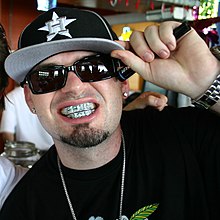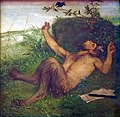Goatee

A goatee is a style of facial hair incorporating hair on one's chin but not the cheeks. The exact nature of the style has varied according to time and culture.
Description
Until the late 20th century, the term goatee was used to refer solely to a
History
The style dates back to Ancient Greece and Ancient Rome. The god Pan was traditionally depicted with goat-like features, including a goatee. When Christianity became the dominant religion and began copying imagery from pagan myth, Satan was given the likeness of Pan,[4] leading to Satan traditionally being depicted with a goatee[5] in medieval art and Renaissance art.
The goatee would not enjoy widespread popularity again until the 1940s, when it became a defining trait of the beatniks in the post-World War II United States. The style remained popular amongst the counter-culture until the 1960s before falling out of favor again. In the 1990s, goatees with incorporated mustaches became fashionable for men across all socioeconomic classes and professions, and have remained popular into the 2010s.
Gallery
-
A Moai kavakava from Easter Island
-
Painting of Pan by Arnold Böcklin (1864–65)
-
Henry M. Hoyt (c. 1865–80)
-
Thomas Settle (c. 1865–80)
-
William H. Hunt (c. 1865–80)
-
Benjamin Disraeli (1878)
-
Thomas Henry Carter (1909)
-
Rob Swire (2009)
See also
References
- ^ "goatee". Merriam-Webster Dictionary. Retrieved 12 April 2024.
- ^ Howard, Rebecca (10 September 1992). "Year of the Goat: Goatee is kicking again". The Globe and Mail. Toronto.
- ^ Shrieves, Linda (12 November 1993). "Goatees, the new hair apparent". The Buffalo News.
- ISBN 0801494095.
- ISBN 978-1-107-17211-1.
External links
 Media related to Goatees at Wikimedia Commons
Media related to Goatees at Wikimedia Commons








